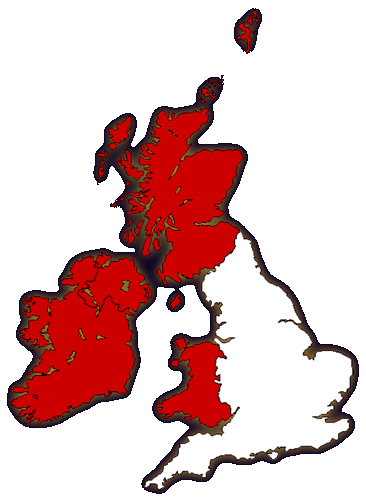A Kingdom Divided
While many countries have a role to play in the evolution of Western Civilisation, one in particular acts as a focal point for the dominance of Thought over Feeling: a group of islands lying to the northwest of the European mainland.
The original Britons were the Celts: a diverse collection of tribes once inhabiting much of Europe. With the expansion of the Roman Empire, many tribes become Romanised, coexisting with their Roman rulers and keeping their lands. But the Roman Empire only extends so far. On the western fringes of Europe, the Celtic mindset still holds sway. The status of these lands as a Celtic stronghold is further bolstered by the westward migration of Celts during the Anglo-Saxon invasions.
The legends of King Arthur are set in fifth century Britain, in the power vacuum following the withdrawal of Roman troops. (Pendragon means “head of the dragon,” placing Arthur symbolically in a place where great forces converge.) On a simple reading of the myths, King Arthur’s goal is to unite the lands of Albion to withstand the encroaching Anglo-Saxons. At a deeper level, he hopes to unite the deeper mysteries (symbolised by the Grail) with the outer court of Camelot (symbolised by the Sword, Excalibur).
When he falls at the battle of Camlann in AD510, the twin-dragon standard is divided, the white dragon (Thought) going to the Saxons in the east, the red dragon (Feeling) taken up by the Welsh in the west.
While the historicity of the Arthurian myths is open to speculation, the legends carry a powerful resonance that persists to this day: a land of two halves, the Anglo-Saxon outlook being one of ambitious, empire-building Thought, the Celtic worldview encompassing a mythical connection to the land: a deep, abiding Feeling.
Examples of this enduring myth are not hard to find: films such as Braveheart and Rob Roy capture the conflict of the red-blooded Celts pitched against the cold-hearted English: a conflict of heart against head.
In truth, the pagan worldview of the original Anglo-Saxon invaders had more in common with that of the Celts than their Roman predecessors, and the early tribal kingdoms tended to be rural, leaving the Roman-built towns deserted. But this changed as the Anglo-Saxons became Christianised during the course of the seventh century.
Christianity had come to the Celts too, but they managed to marry the new solar religion with the nature-based religion of the Druids. Celtic Christianity maintained many pagan elements, the emphasis being on holy hermits, pilgrimage and nature while Roman Christianity was characterised by monks, monasteries and the priesthood: an urban rather than rural existence, in keeping with the centralised and structured hierarchy of an empire.
The Synod of Whitby in AD664 is considered by many to be an important turning point, the time when Roman Christianity won out over Celtic Christianity as the prevailing religion of Britain. In actuality, the synod was a parochial affair, deciding the nature of the Church in Northumbria rather than the whole country. Nevertheless, the event serves as a historical point of focus. Solar forces are continuing to flourish; the nature-connection is on the decline.
Reality is rarely as clear-cut as our interpretation of it and this is a necessarily simplistic account. Nevertheless, the marginalisation of the Celtic races by prevailing solar forces established two mindsets which have defined the history and politics of these lands, and continue to do so right up to this day.
In broad brushstrokes, the mindsets can be characterised as follows:
country/nature
connection to the land
the strength of the family
community
heart
Feeling
town/city
industry/progress
the strength of the state
capitalism
head
Thought


 TOP
TOP NEXT
NEXT